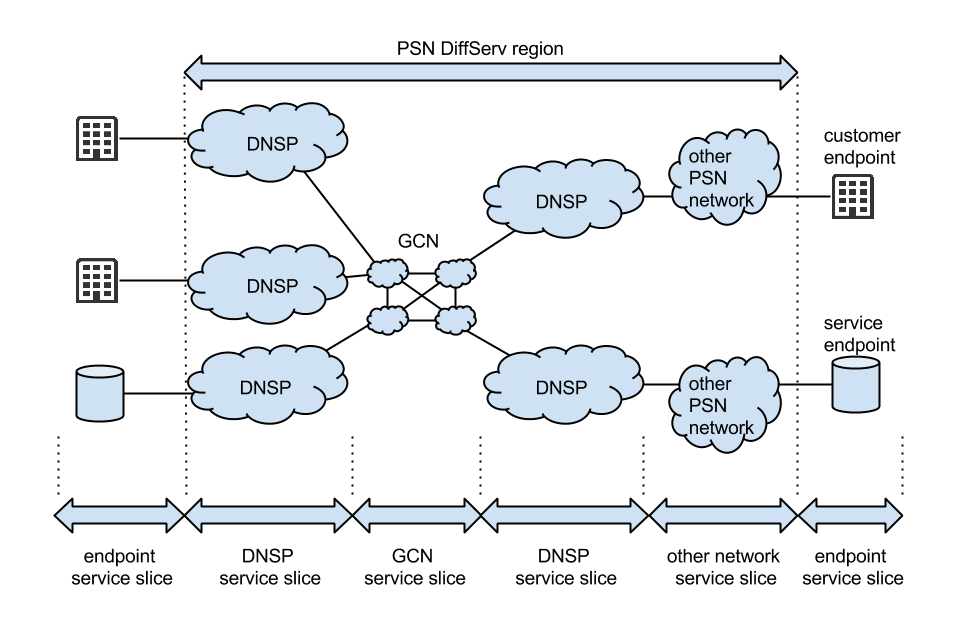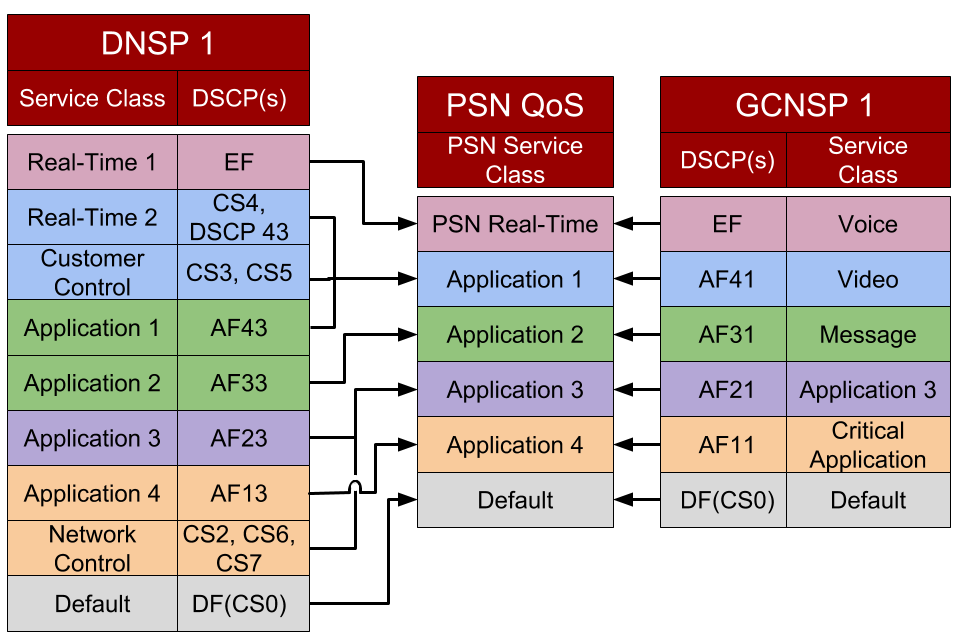PSN Quality of Service (QoS) specification
Updated 3 May 2016
Both Government Conveyance Network Service Provider (GCNSP) and Direct Network Service Provider (DNSP) networks need to support the 6 PSN service classes and their performance requirements. Other PSN network services need to recognise these classes and use them for all traffic that transits to GCN and DNSP networks.
The PSN DiffServ region
The PSN DiffServ region is capable of supporting differentiated services along all paths spanning all providers in the region.
PSN operates as a single network, and provides a contiguous standards-based IP Quality of Service (QoS) model for all PSN consumers and service providers. The DiffServ architecture RFC2475 is used to provide SLA assurance for multiple service classes while maintaining isolation between the behaviours of each service class.
Each DNSP, GCNSP and other PSN network represents a discrete DiffServ domain with the PSN. Network to Network Interconnects (NNIs), both Points of Connection (PoC) and Points of Interconnection (PoI), acting as DiffServ domain boundaries link the PSN DiffServ region as a whole.
Note: for the purposes of brevity, it is assumed each service provider functions as a DiffServ domain only.

The PSN DiffServ region. This diagram shows the PSN DiffServ region spans all network services, including the GCN, DNSPs and other PSN network services. The diagram is divided into service slices for each service.
There are two main traffic flows within the PSN DiffServ region. These are:
- on-net - where the end-to-end path remains inside a single DiffServ domain and never traverses to another DiffServ domain
- cross-net - where traffic originating in one DiffServ domain crosses or terminates in another
PSN service classes
The PSN QoS model enables PSN service providers to continue using their existing QoS policies and associated service class names within their respective networks.
A service class RFC4594 represents a set of traffic that requires specific delay, loss, and jitter characteristics from the network. More generally, a service class pertains to applications with similar characteristics including bandwidth assurance and performance requirements. The service classes are used to provide different forwarding treatments to address consumer, application, or network requirements.
Obligation QOS.2: mandatory for GCNSPs, DNSPs and other network services
All providers providing packet transport services using Multi Protocol Label Switching (MPLS) must align their QoS service class policies to the PSN 6 service class QoS model throughout the Diffserv region.
GCNSPs must provide only the fixed 6 PSN service classes.
DNSPs and other network service providers may have more or fewer service classes but must demonstrate how they map to the PSN 6 classes consistent with consumer traffic type requirements.
The PSN Diffserv region is comprised of the discrete networks (Diffserv domains) provided by GCNs, DNSPs and other PSN network providers.
The PSN service classes and Differentiated Services Code Points (DSCPs) are defined as:
| Service Class Name | DiffServ PHB(s)* | Recommended DSCP(s) |
| PSN real-time | RFC3246 (EF PHB group) | EF |
| PSN application class 1 | RFC2597 (AF PHB group) | AF4x, CS4, CS5 |
| PSN application class 2 | RFC2597 (AF PHB group) | AF3x, CS3 |
| PSN application class 3 | RFC2597 (AF PHB group) | AF2x, CS2, CS6, CS7 |
| PSN application class 4 | RFC2597 (AF PHB group) | AF1x, CS1 |
| PSN default | RFC2474 (DF PHB) | DF (CS0) |
The Expedited Forwarding (EF), Assured Forwarding (AF) and Default Forwarding (DF) Per Hop Behaviours (PHBs) should function as class selector compliant PHBs.
Obligation QOS.5: mandatory for GCNSPs, DNSPs and other network services
All DNSPs and other network services providing packet transport services using MPLS must align their respective QoS policy Differentiated Services Code Point (DSCP)/ Experimental (EXP) markings to the PSN QoS model at their edge nodes.
For DNSPs this is at the DNSP edge node connected to the GCN PoC NNI. Here, the GCNSP must provide the respective PSN QoS marking alignment scheme as part of the respective peering policy.
For other network services this is at the edge node connected to the DNSP PoC NNI. Here, the DNSP must provide the respective PSN QoS marking alignment scheme as part of the respective peering policy.
Obligation QOS.6: mandatory for GCNSPs
GCNSPs must mutually agree as part of one another’s PoI NNI/ peering agreement as to which GCNSP’s PoI interface will perform the marking alignment to the PSN QoS model.
Obligation QOS.7: mandatory for GCNSPs, DNSPs and other PSN networks
The PSN DiffServ region must also support the Class Selector (CS) PHB in line with the stipulations outlined in RFC4594.
Example of alignment to PSN service classes
This illustration shows an example of how a DNSP and GCNSP would align their respective QoS policies to the PSN QoS model:

Service class alignment to PSN QoS service classes. This diagram shows how to align standard service classes to the PSN QoS service classes. Email psnservicedesk@digital.cabinet-office.gov.uk to request a list of service classes and instructions on aligning them to PSN service classes.
PSN edge node capability requirements
Obligation QOS.9: mandatory for DNSPs and other network services
The PSN DiffServ edge node must be able to support a minimum set of QoS capabilities over the PSN access circuit and logical connections. It must be possible to:
- allocate dedicated bandwidth to logical connections on the same access circuit
- allocate bandwidth sharing between logical connections on the same access circuit
- allocate minimum bandwidth guarantees to individual PSN service classes within each logical connection
- allocate minimum bandwidth guarantees to individual PSN service classes across a shared pool of bandwidth on the same access circuit
- support performance metric differentiation between the PSN real-time service class, PSN application classes (application class 1-4) and PSN default service class
- distribute unallocated bandwidth to PSN service classes over and above the service minimum guarantees
For clarification: this statement is intended to stipulate a requirement to support the capability as described in the bullet points should a consumer request QoS capabilities on their access links. It does not state it must be implemented on the tail for all consumer sites as a matter of course.
PSN real-time service class
Obligation QOS.27: mandatory for GCNSPs, DNSPs and other network services
The real-time service class:
- must comply with the DiffServ EF PHB group RFC3246
- must function as a low-loss, low-delay, and low-jitter PHB
- typically carries voice or telephony signalling
- may be used for any application requiring similar service characteristics (as above) without causing the service class to malfunction
PSN application classes
Obligation QOS.28: mandatory for GCNSPs, DNSPs and other network services
The 4 PSN application classes are based on the DiffServ AF PHB groups. Each application class must:
- comply with minimum guaranteed amount of forwarding resources such as buffer space and bandwidth
- not pre-empt the forwarding resources specifically allocated to each of the other application classes
Each application class may:
- evenly allocate remaining resources on the respective interface or connection between the application classes and the default class once the minimum guaranteed resource allocations are given to each application class
PSN service providers must:
- accept all three drop precedence codepoints for each application service class
- implement a minimum of two different levels of loss probability
PSN service providers may:
- offer application class performance differentiation (such as delay or jitter) for on-net traffic via consultation and procurement of services
PSN default service class
Obligation QOS.29: mandatory for GCNSPs, DNSPs and other network services
The default service class:
- must be compliant with the DiffServ default PHB group
- must forward packets received with an unrecognized codepoint or EXP as if they were marked for PSN default class
PSN performance slices
A PSN end-to-end composite QoS performance metric comprises a set of metrics accumulated over a number of network ‘performance slices’. A ‘performance slice’ in this context is a section of the PSN end to end network path with unique or discrete performance attributes.
From a customer’s perspective, a PSN composite QoS performance metric will typically use performance slices to comprise a set of metrics which show:
- a source consumer LAN/WAN network
- a source PSN access circuit
- a source PSN network that is not a DNSP (this is optional)
- a source DNSP network
- the GCN (consisting of any two GCNSP networks)
- a destination DNSP network
- a destination PSN network that is not a DNSP (this is optional)
- a destination PSN access circuit
- a destination consumer LAN/WAN network
QoS performance requirement
Obligation QOS.4: mandatory for GCNSPs and DNSPs
GCN performance metrics
The GCN service must be designed to exceed the following performance target, measured from any GCNSP edge node to any other GCNSP edge node:
| PSN QoS service class | Round-trip latency (ms) | Two-way packet loss ratio (%) | Jitter - One-way IP packet delay variation (ms), in each direction |
| PSN real-time | 25 | 0.02%, equivalent to 3.84 in 19200 packets | 3 |
| PSN application class 1 | 25 | 0.04%, equivalent to 7.68 in 19200 packets | 5 |
| PSN default | 25 | 0.2%, equivalent to 38.4 in 19200 packets | unspecified |
DNSP performance metrics
(this text was clarified in April 2016)
Each DNSP service must be designed to exceed the following performance target, measured from any of its DNSP edge nodes (the device in the provider’s network/pop into which the customer tail circuit is connected) to any of its GCN edge nodes:
| PSN QoS service class | Round-trip latency (ms) | Two-way packet loss ratio (%) | Jitter - One-way IP packet delay variation (ms), in each direction |
| PSN real-time | 18 | 0.2%, equivalent to 38.4 in 19200 packets | 2 |
| PSN application class 1 | 18 | 0.2%, equivalent to 38.4 in 19200 packets | 2 |
| PSN default | 18 | unspecified | unspecified |
Any service offered to customers that uses PSN service classes must meet these specifications for PSN service classes.
Out-of-contract and in-contract markings
Obligation QOS.10: mandatory for GCNSPs and DNSPs
To enable end-to-end out-of-contract and in-contract service continuity, DNSPs and GCNSPs must:
- accept all three drop precedence Diffserv codepoints on the PoC and PoI NNIs
- not reclassify any PSN application class to the PSN default service class
Encryption
The IPSec protocol RFC4301/4302/4303 does not include the IP header’s DiffServ field in any of its cryptographic calculations. Modification of the DiffServ outer IP header DSCP codepoint by a PSN DiffServ node is acceptable and will not affect the IPSec integrity checks.
